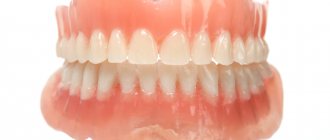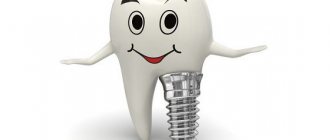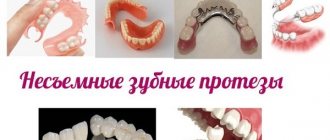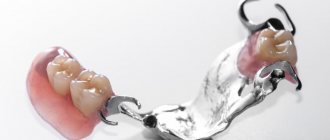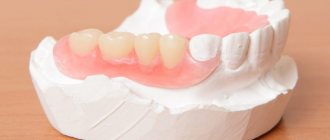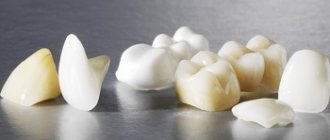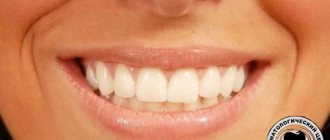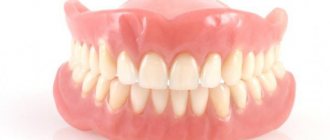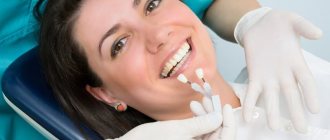Author of the article: Tsurkan Vladislav Gennadievich
Doctor-expert
Specialization: Dentist-orthopedist
Total work experience: since 2021
- Partially removable
Clasp
- QuattroTi
- Without sky
- Conditionally removable
- Which removable dentures are better?
With complete edentia
- With partial edentia
- For the upper jaw
- For the lower jaw
Restoring the dentition using removable dentures can be an alternative to fixed structures, especially when the latter have contraindications. To understand which type is suitable in your case, you need to know what removable dentures are available and how to choose the one that is best.
How a partial denture is attached to the jaw
There are 3 options for fastening removable structures: hooks (clasps), locks (attachments), telescopic crowns.
We propose to consider each of the options in more detail. Clasps. They are hooks made of metal or plastic that grip healthy teeth and fix the orthopedic structure in the mouth. The disadvantage of such fastening is poor fixation and unsatisfactory aesthetics. Despite the fact that the hooks are covered by the lip, they are visible to others when smiling and talking.
Attachments. More preferable from an aesthetic point of view. The special lock consists of 2 parts. One element is built into the base of the prosthesis, and the other is attached to the crown that covers your own tooth. This fastening option has a more reliable fixation and gives the product stability. In addition, the attachments distribute the chewing load more evenly, which slows down bone atrophy by almost 2 times.
Telescopic crowns. Presented by a system consisting of 2 crowns. The inner one follows the contours of the ground tooth. The outer one is connected to the base and restores the shape of the tooth. This allows the prosthesis to be securely fixed and prevents it from moving. The possibility of installing a telescopic structure in each specific case is determined by the doctor, since grinding of a large layer of hard tissue of the supporting tooth is required.
Metal alloys
As a rule, it is a compound of chromium, nickel and cobalt. The advantage of such materials is their increased resistance to mechanical stress.
Disadvantage: high allergenicity. In patients prone to allergic manifestations, adverse reactions occur frequently.
The preferred material is an alloy of platinum, palladium and gold. The prosthesis from it will be:
- Expensive, but safe and durable.
- Be comfortable and give a feeling of naturalness;
- With a ceramic coating, it will completely match the appearance of natural teeth.
Titanium is a popular and most modern solution in prosthetics.
Titanium prostheses:
- Durable;
- Safe;
- Lungs.
The only drawback is the lack of full compliance with aesthetic requirements. Titanium crowns are placed on the far molars. Here they are not visible to others, but they perform their task flawlessly.
Zirconium oxide remains the traditional choice:
- Lasting;
- Stable;
- Biologically compatible and safe;
- Meeting high aesthetic requirements;
- The color matches the natural enamel of the teeth.
Thanks to laser processing, artificial teeth made of zirconium dioxide completely match the natural shape of the tooth being restored.
Indications and contraindications for use
Partial removable dentures are used in cases where the jaw is missing only a few teeth, but there are own healthy teeth that will be used as supporting teeth. Suitable for restoring both chewing and front teeth. The use of removable partial dentures is recommended in the following cases:
- missing several teeth;
- end defects of the jaw;
- atrophied bone tissue;
- the need for temporary prosthetics;
- contraindications to the installation of implants.
There are practically no contraindications to this type of prosthetics, and they are all temporary. These include viral diseases, carious lesions of teeth and periodontal tissue diseases.
Features and types of dental prosthetics, pros and cons
If we talk about dental prosthetics, each type has its own characteristics, positive and negative sides:
- Anterior dentures should look aesthetically pleasing and be installed as quickly as possible. For this purpose, temporary structures are widely used, allowing you to choose an individually suitable color and shape of teeth.
- When premolars and molars need prosthetics, their main function – chewing food – comes to the fore. Accordingly, the structure must be durable, meet the anatomical features of this type of teeth and withstand significant loads. Modern ceramic inlays, zirconium and metal-ceramic crowns meet these requirements.
In dentures, there are several categories: partially removable, removable, conditionally removable, and fixed prosthetics.
Partially and completely removable dentures include:
- clasp
- lamellar
Conditionally removable dental prosthetics include the following prostheses:
- with screw fixation on the implant
Non-removable ones include:
- crowns
- veneers
- tabs
- Lumineers
- bridge structures
- implants
Stages of manufacturing a removable partial denture
Depending on the type of prosthesis, the course of orthopedic treatment may differ slightly, but, in general, prosthetics can be divided into several main stages:
Preparation. After examination and diagnosis, the orthopedic doctor draws up a treatment plan and helps with choosing the optimal design option suitable for your particular case. At this stage, the oral cavity is sanitized. If necessary, teeth that cannot be saved are removed.
Taking impressions. Using impression material and a custom tray, the specialist takes impressions of the teeth on both jaws.
Manufacturing of the structure. In the dental laboratory, wax models are cast from the impressions, from which the technician makes the dentures.
Fitting and fixation. At the last visit, the doctor tries on the structure and fixes it in the oral cavity. If necessary, the prosthesis is adjusted and polished according to the bite.
Lifespan of removable partial dentures
Practice shows that the service life of removable plate structures is on average 3-5 years, after which the structure has to be changed. Bugel products have a longer lifespan - up to 5-7 years.
In general, the duration of wearing depends on several factors:
— the quality of the design and the professionalism of the specialist who carried out the installation;
— characteristics of the body and the condition of the oral cavity, the presence of gum diseases and deformation of the dentition;
— accuracy of compliance with doctor’s recommendations and proper home care.
Rules for wearing and caring for prostheses
The first time after installation, removable dentures can cause discomfort. As a rule, it goes away by the end of the first week. In some cases, especially when using plate structures, addiction can last up to 3 weeks.
To speed up adaptation, there are general rules and recommendations: rinse your mouth with warm water more often, do not overload the denture with solid food for the first 3-4 days.
Carefully monitor hygiene, rinse your mouth after every meal, and beware of excessive chewing loads. For cleaning, you should not use abrasive cleaners; give preference to special solutions and pastes.
Are partial dentures repairable?
During use, individual parts of the prosthesis may break off. Under no circumstances should you attempt to repair it yourself; it is better to contact a specialist. If the situation can be corrected, it will only take a couple of days to fix it.
Every six months to a year, during a scheduled visit to the dentist, it is necessary to reline the plate and clasp structures, since the contour of the gums and the level of bone tissue change over time. The adjustment improves fit and load distribution, resulting in the product not chafing or breaking.
Immediate
Replace a unilateral included defect. The design can be created from any materials used in dentistry. Capable of restoring a row of holes. Also found under the name "butterflies".
Several artificial crowns are attached to a miniature base, secured with hooks and locks. Recommended as a temporary solution after removal of diseased masticatory organs.
For those who are going to install metal ceramics and do not have enough money, it helps to gain time to collect them. Some patients use it all their lives, replacing it with a new one after a few years.
The most frequently asked questions about partial dentures
Is an allergy possible? How long does it take to get used to? Do you need fixing gels when wearing? You can find out the answers to these and other most popular questions in this section of the article.
— Is it possible to have an allergic reaction?
Is it possible. As a rule, an allergy can occur to acrylic when wearing plate dentures. Or on metal if wearing a clasp design. Before installing a prosthesis, a doctor may recommend that particularly sensitive people undergo a special test for sensitivity to materials.
— How long does it take to get used to it?
Sometimes it can take up to 3-4 weeks to get used to it. This usually applies to plate dentures, since they are more noticeable in the oral cavity. Clasp designs do not require so much time.
— Do I need to use fixing gels when wearing partial structures?
Partial structures do not require additional fixation, since they already have fastenings (hooks or clasps).
— Do I need to take off my dentures at night?
It is not at all necessary to remove the structure at night. It is not even recommended to remove the prosthesis for the first 3-4 weeks after installation, since there is an adaptation period. Further, at the discretion of the patient.
— Are there any restrictions when wearing?
Avoid eating excessively hard foods such as nuts or ice. It is also not recommended to eat foods that are too viscous and stick to artificial teeth.
What can be done in case of complete absence of upper teeth?
For complete prosthetics of the upper jaw, 2 types of orthopedic structures are suitable - removable suction cups and dentures on implants. The “suction cup effect” or “closing valve” in case of complete edentia is characteristic of acrylic, nylon and Acry-free covering modifications. They are equipped with a massive artificial palate of a special design - after installation above the prosthesis (between it and the palate), excess air comes out, and the base seems to be sucked to the anatomical palate using a “technical vacuum” zone. Over time, due to progressive atrophy, the “sucker” stops working and the person has to use a fixing cream.
As for prostheses on implants, in case of complete edentia, fixed structures are again recommended - bridges or arched prostheses, including 10-14 crowns and a small amount of artificial gum. They have the most reliable and durable fixation. Now there are a lot of progressive protocols that allow you to restore all upper teeth without sinus lifting and osteoplasty in just 1 day - for example, All-on-4, All-on-6, basal and zygomatic methods. However, there are also removable systems on implants that the patient can remove at home himself. But their fixation weakens over time, which is an obvious drawback.
Read on the topic: what you need to do to get used to dentures as quickly as possible.
Partial dentures - reviews from specialists and patient opinions
In general, reviews of removable dentures from patients and doctors are positive. If there are contraindications to the installation of fixed structures, removable prosthetics are the only treatment option.
However, experts are confident that if there are no restrictions on implantation, the choice should be opted for prosthetics on implants. This option is the most preferable in terms of longevity, aesthetics, safety and prevention of bone atrophy.
Composite
The composite is durable and has a long service life. Its only drawback is the high price. But if you need a prosthesis for life, it makes sense to resolve the issue in favor of this composition. Composite is a polymer with many additives that provide exceptional strength and make artificial teeth look like real teeth.
Prosthetics are carried out according to the following algorithm:
- A polymer composition is applied to the prepared area in layers, giving it the shape of a lost tooth;
- Each layer is dried with a special lamp.
As a result of this build-up, the tooth becomes stronger and regains its lost shape. The doctor may use a pin to strengthen the structure. The pin is installed into the remains of the tooth or directly into the root canal.
What is the cost of a partial denture?
First of all, the price varies depending on the type of prosthesis and the number of lost teeth. Many are sure that a high-quality prosthesis cannot be very cheap. So what does its cost consist of?
The material of construction plays a big role in pricing. Modern dental clinics work with proven compounds for the manufacture of structures. This guarantees the quality, aesthetics and durability of the product.
All designs are made individually, based on the characteristics of the jaw structure, patient preferences and doctor’s recommendations.
Professionalism of staff and technical equipment. The experience of an orthopedist and dental technician, as well as high-tech equipment, is very important, so the price tag also adds up in terms of costs.
Where in Voronezh can a partial removable denture be installed?
For a quality result, it is important to choose a dental clinic and attending physician wisely. Making the wrong choice can create a lot of problems and cost you a lot of time and money to fix the mistake. Be sure to pay attention to the specialist’s experience, the availability of modern equipment and reviews of other patients.
You can install partial removable dentures in Voronezh at. We offer production using modern equipment, high-quality materials and competitive prices. Our consummate specialists are always ready to help. We are waiting for you for your first free consultation!
